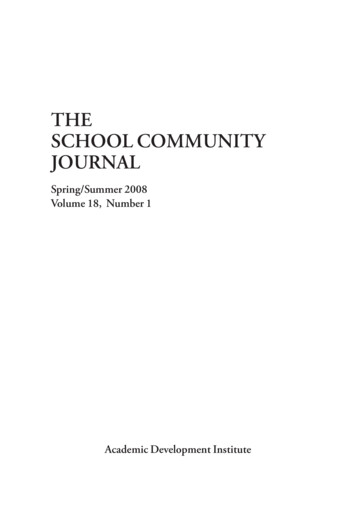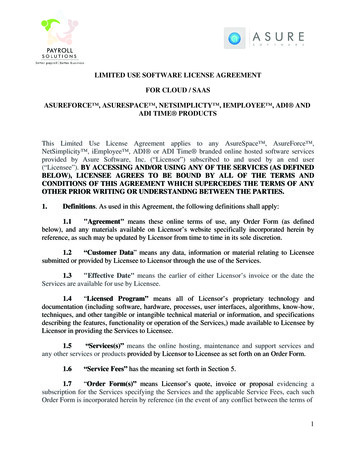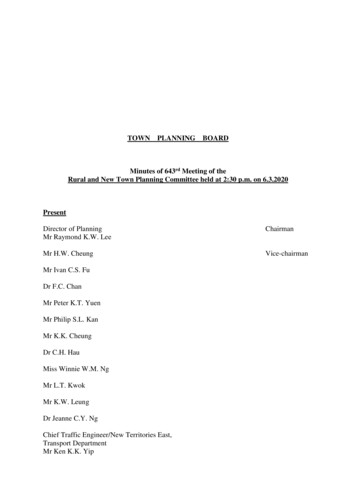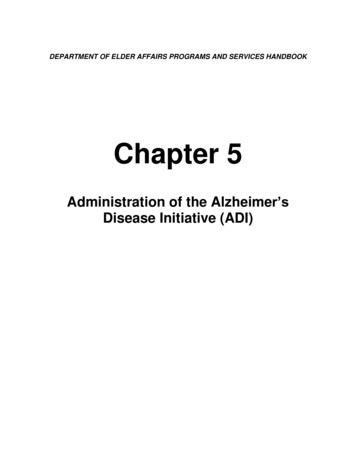
Transcription
THESCHOOL COMMUNITYJOURNALSpring/Summer 2008Volume 18, Number 1Academic Development Institute
ISSN 1059-308X 2008 The Academic Development InstituteBusiness and Editorial OfficeThe School Community Journal121 N. Kickapoo StreetLincoln, IL 62656 USAPhone: 217-732-6462Fax: 217-732-3696E-mail: editor@adi.orgRequests for ManuscriptsThe School Community Journal publishes a mix of:(1) research (original, review, and interpretation), (2) essay and discussion, (3) reports fromthe field, including descriptions of programs, and (4) book reviews.The journal seeks manuscripts from scholars, administrators, teachers, school board members, parents, and others interested in the school as a community.Editorial Policy and ProcedureThe School Community Journal is committed to scholarly inquiry, discussion, and reportage oftopics related to the community of the school. Manuscripts are considered in four categories:(1) research (original, review, and interpretation),(2) essay and discussion,(3) reports from the field, including descriptions of programs, and(4) book reviews.The journal follows the format suggested in the Publication Manual of the American Psychological Association, Fifth Edition.Contributors should send, via e-mail attachments of electronic files(in Word if possible):the manuscript; an abstract of no more than 250 words; a one paragraph description (each) ofthe author(s); and a mailing address, phone number, fax number, and e-mail address where theauthor can be reached to:editor@adi.orgThe cover letter should state that the work is not under simultaneous consideration by otherpublication sources. A hard copy of the manuscript is not necessary unless specifically requestedby the editor.As a refereed journal, all submissions undergo a blind peer review as part of the selectionprocess. Therefore, please include the author’s description and other identifying information ina separate electronic file.Subscription to The School Community JournalThe School Community Journal is published twice annually – fall/winter and spring/summer.The School Community Journal is now a free, open access, online-only publication. Therefore, weare no longer accepting subscriptions.The archives to the journal may be accessed at http://www.adi.org/journal
ContentsHelping Teachers Work Effectively with English Language Learnersand Their FamiliesCheng-Ting Chen, Diane W. Kyle, andEllen McIntyre7Understanding the Culture of Low-Income Immigrant Latino Parents:Key to InvolvementGraciela L. Orozco21Family Involvement in a Hawaiian Language Immersion ProgramLois A. Yamauchi, Jo-Anne Lau-Smith, andRebecca J. I. Luning39Constructing Families, Constructing Literacy: A Critical Analysisof Family Literacy WebsitesJim Anderson, Kimberly Lenters, andMarianne McTavish61Promising Website Practices for Disseminating Research onFamily-School Partnerships to the CommunityNancy Feyl Chavkin and Allan Chavkin79Public Libraries – Community Organizations Making OutreachEfforts to Help Young Children Succeed in SchoolGilda Martinez93A Proposal for Involving Teachers in School Integrated Services105in the Province of QuébecNathalie S. Trépanier, Mélanie Paré, Hariclia Petrakos,and Caroline DrouinBook Review—123K
Editorial Review BoardJeffrey A. AndersonIndiana Univ. Purdue Univ. IndianapolisKate McGillyParents as Teachers National Center, St. LouisJi-Hi BaeSungshin Women’s University, Seoul, KoreaOliver MolesSocial Science Research Group, LLC,Rockville, MarylandBrian R. BeaboutPenn State University, University ParkAlison Carr-ChellmanPenn State University, University ParkSusan DeMossSchool Administrator, Oklahoma CityGermaine EdwardsCenter on Innovation & Improvement,PhiladelphiaKaren EstepLincoln Christian College, Lincoln, IllinoisKaren GerdtsConsultant, Salem, New HampshireKaren GuskinParents as Teachers National Center, St. LouisDiana Hiatt-MichealPepperdine University, Malibu, CAPat HulseboschGallaudet University, Washington, DCFrances KochanAuburn University, AlabamaJean KonzalProfessor Emerita, The College of New JerseyRobert LeierESL Coordinator, Auburn University, ALVera LopezArizona State University, TempePamela LoughnerConsultant, Huntingdon Valley, PAWalter MalloryVirginia Tech Northern Ctr., Falls ChurchMarilyn MurphyCenter on Innovation & Improvement,PhiladelphiaAlberto M. OchoaSan Diego State University, CaliforniaReatha OwenAcademic Development, Lincoln, ILEva PatrikakouDePaul University, ChicagoConstance PerryUniversity of Maine, OronoReyes QuezadaUniversity of San Diego, CaliforniaTimothy QuezadaEl Paso Community College, TexasA. Y. “Fred” RamirezCalifornia State University, FullertonCynthia J. ReedTruman Pierce Institute, Auburn, ALMelissa SchulzUniversity of Cincinnati, OHSteven B. SheldonCenter on School, Family, & CommunityPartnerships, Johns Hopkins UniversityLee ShumowNorthern Illinois University, DeKalbElise TrumbullCalifornia State University, Northridge
Editor’s CommentsLori ThomasJune 2008
THE SCHOOL COMMUNITY JOURNAL
Helping Teachers Work Effectively with EnglishLanguage Learners and Their FamiliesCheng-Ting Chen, Diane W. Kyle, and Ellen McIntyreAbstractMany classroom teachers across the United States feel unprepared to workwith students and families who speak limited or no English. Knowing thatschools are accountable for the achievement results of these students, teachersincreasingly seek help. This article describes a professional development project designed to introduce K-12 teachers to effective strategies for enhancingthe learning of English language learners and shares the results that occurredas the teachers placed greater emphasis on family involvement practices. TheSheltered Instruction and Family Involvement (SIFI) project introduced theteachers to research on the effects of family involvement on students’ academicachievement and asked that participants develop plans for involving familiesmore intentionally. Results of the project, documented in survey responses andin evidence shared at a culminating project event, indicated changes in manyteachers’ views and practices of family involvement. Teachers reached out tofamilies in new ways and made their instruction more connected to students’background knowledge. They also acknowledged the challenges involved. Despite the challenges, however, the professional development experience led topractices that are more likely to help English language learners achieve greateracademic success.Key Words: English Language Learner (ELL), English as a Second Language(ESL), family involvement, sheltered instruction, Sheltered Instruction Observation Protocol (SIOP), professional development, teacher practices, parentsThe School Community Journal, 2008, Vol. 18, No. 1
THE SCHOOL COMMUNITY JOURNALIntroductionClassroom teachers across the United States face an overwhelming challengein working with students and families. Teachers have been consistently unprepared to work with immigrants and refugees and others who speak limited orno English (Gándara, Maxwell-Jolly, & Driscoll, 2005; National Center forEducation Statistics [NCES], 2002). Add to this the high-stakes accountabilityof schools which must include the achievement results of these students, andwe can understand teachers’ requests for help. This article describes an attemptto provide assistance to a group of elementary, middle, and high school teachers who devoted 18 months to learning strategies designed to help this growingpopulation of students and shares the results that occurred as the teachers focused on family involvement practices.Changing Demographics and Resulting ChallengesChanging student demographics correspondingly raise issues of teacher quality. The increasing number of immigrants from non-English speakingcountries makes our schools more ethnically and linguistically diverse. According to U.S. census data (U.S. Census Bureau, 2007), 12.54% of the populationin 2006 was foreign-born. Further, 19.7% reported speaking a language otherthan English at home, and 8.7% described themselves as speaking English lessthan “very well.” Moreover, the U.S. Census projected that students whosefirst language (L1) is not English will represent about 40% of the K-12 studentpopulation in the Unites States by the year 2030 (Thomas & Collier, 2002).The academic achievement of English Language Learners (ELLs) has continued to lag significantly behind that of their peers. This may be, in part,because their teachers struggle with knowing how to teach them effectively. According to the National Center for Educational Statistics’ Schools and StaffingSurvey of 1999-2000 (NCES, 2002), only 12.5% of teachers with ELLs reported having eight or more hours of training in the previous three years on how toteach those students. A recent survey of more than 5,000 teachers in Californiaconducted by Gándara, Maxwell-Jolly, and Driscoll (2005) reported that “during the last five years, 43% of teachers with 50% or more English learners intheir classrooms had received no more than one in-service that focused on theinstruction of English learners” (p. 13). Half of the teachers in classrooms inwhich 25-50% of the students were English language learners had no (or almost no) professional development in working with ELLs.Compounding the problem, assessment standards have increased as the NoChild Left Behind Act of 2001 (NCLB) demands that these students achieve
HELPING TEACHERS & ELL FAMILIESas their peers. This expectation heightens the critical need for teachers to knowhow to provide appropriate instruction for this population of students nowpresent in classrooms across the nation and how to reach out and work effectively with students’ families.Providing Help Through Professional DevelopmentParticipants in this study took part in one of two cohorts in an 18-monthprofessional development initiative. The Sheltered Instruction and Family Involvement (SIFI) project focused on helping teachers learn and provide“sheltered instruction” (e.g., strategies designed to help students learn contentat the same time they develop English proficiency) to improve the academicachievement of English language learners as well as positive family involvementpractices which link to higher achievement for all students.Participants in the project learned about and implemented the instructional strategies suggested by Echevarria, Vogt, and Short (2004) for workingwith ELLs (data on the implementation of the model is presented elsewhere;see McIntyre, Kyle, & Chen, 2007). The Sheltered Instruction ObservationProtocol (SIOP) model is a means for making grade-level academic contentaccessible to English learners while at the same time promoting their languageand literacy development. SIOP includes eight components: preparation,building background, comprehensible input, strategies, interaction, practice/application, lesson delivery, and review/assessment. Research on the model hasindicated that it provides a reliable and valid way to measure sheltered instruction (Guarino et al., 2001). Further research has demonstrated that Englishlearners benefit when their teachers have been trained to use SIOP and implement it with fidelity. In a study reported by Echevarria, Short, and Powers(2006), English languague learners in such classrooms not only improved theirwriting skills, but also outperformed students in control classes of teachers whohad not received SIOP training.In addition to training in the implementation of the SIOP model, the project reflected research which has shown the positive connection between parentinvolvement and students’ academic success (Marcon, 1999; Miedel & Reynolds, 1999; Sanders & Herting, 2000). Teachers learned how to reach out tofamilies in respectful ways and to learn from them (Kyle et al., 2002). The project challenged the deficit view many teachers hold toward parents of poverty,language difference, or low education by showing how to see and build fromfamilies’ strengths and funds of knowledge (Moll & Gonzalez, 2004).Further, the project combined the content of instructional practices shownto be effective with ELLs and family involvement with a powerful model of
THE SCHOOL COMMUNITY JOURNALprofessional development (Darling-Hammond, 1998; Goldenberg & Gallimore, 1991; Tharp & Gallimore, 1993). This model focuses on socioculturalprinciples for learning (Tharp & Gallimore). Novices and experts worked together to learn about effective strategies, planned appropriate lessons for ELLs,and engaged in reflective dialogue about how to best meet the needs of thetarget students. Further, other teachers and the leadership team assisted theirperformance as they made attempts to learn new strategies. As the followingreflections by some of the teachers illustrate, they found the approach to professional development beneficial in their growth as teachers of ELLs, specifically,as well as in teaching all learners, in general: I love the hands-on strategies presented. I’ll be a better teacher starting nextweek! The strategies that were shared today will be beneficial not only to my ELLstudents but all my students. Best practices in education benefit everyone. I now feel more confident, especially planning language objectives. Restating content objectives and building language objectives intentionallyin lesson plans will help me and improve my students’ ability to understanda lot faster – all of my students.Project Emphasis on Family InvolvementAs noted, the project emphasized the positive, respectful, and necessaryinvolvement of families in supporting student learning and academic achievement. More specifically, participants received information about currentresearch reporting the positive effects of parent involvement on students’ academic achievement, and they read and discussed books and articles describingpractical and proven family involvement strategies to implement in classrooms.The SIFI project also included specific readings and discussions about the valueof “family visits” (home visits) as well as guidelines for planning, conducting,and learning from such experiences for those teachers who might want to explore this possibility.The SIOP component on building background specifically addresses theimportance of tapping into the background of unique experiences and knowledge that English language learners bring with them. Echevarria et al. (2004)suggest three indicators of this component for teachers to address in their planning and teaching: “concepts linked to students’ background, links betweenpast learning and new learning, and developing key vocabulary” (p. 44). Teachers who understand students’ backgrounds of experiences and interests andrelate what students need to learn to what they have learned previously are10
HELPING TEACHERS & ELL FAMILIESbetter able to provide the scaffolding needed by students who are confrontingnew academic content (and, for many, in a new language as well).The teachers in the project developed action plans of their intended goalsin working with their ELLs, including planned strategies for involving andlearning from families more intentionally and more often. Project meetings included time for the teachers to share their efforts and get feedback from theirpeers. As a culminating event of the project, a “Share Fair” became a time forparticipants to showcase particularly successful attempts and results. To an audience of visitors invited to the event, the teachers provided tri-fold posters ofphotos, PowerPoint presentations, examples of projects students and their families developed, and other materials from their work with families.Methods and Data SourcesThe project was conducted with two cohorts of teachers. Twenty classroom teachers and three district level administrators completed Cohort 1, and15 teachers completed Cohort 2. The teachers taught across all grade levels,K-12. Data sources for the entire project included: observations of teachers’instruction based on the SIOP rubric, analyzed to determine percentages ofimplementation of the SIOP components for individuals and across the participants; results of students’ achievement on a literacy assessment in projectteachers’ classrooms matched with students in non-project classrooms, analyzed to determine differences in academic growth; and teachers’ open-endedreflections at the end of each session about their perceptions of the professional development, analyzed to determine patterns of views about the sessionsand materials, thoughts about implementation of SIOP and family involvement strategies, and concerns (see McIntyre, Kyle, & Chen, 2007 for results ofteachers’ instructional changes and students’ achievement).This article reports on the family involvement data only. In addition to theabove data sources, participants completed surveys at the beginning and endof the project about the type and frequency of their parent involvement strategies and activities. At the beginning of the project, the 20 Cohort 1 teachersresponded to a survey developed by the project directors, and 18 completed thesame survey at the end. For Cohort 2, the project directors used a validated survey about parent involvement developed at Johns Hopkins University (Epstein& Salinas, 1993). Eighteen participants completed the survey at the beginningof the project, and 1 2 participants completed the survey at the conclusion ofthe project.The percentages of responses and narrative comments included on the surveys were analyzed to determine the extent and nature of the involvement11
THE SCHOOL COMMUNITY JOURNALstrategies teachers employed and any changes that occurred over the durationof the project. In addition, as noted above, participants presented documentation about their family involvement practices in a culminating Share Fair, andthese materials were collected for further analysis.Changes in Teachers’ Views and Practices: Cohort 1At the beginning of the project, most of the Cohort 1 teachers saw familyinvolvement in traditional ways (e.g., parent conferences, report cards, etc.).Some teachers had made efforts to have positive interactions with families,but few went out of their way to attempt to build trusting relationships withfamilies. For example, the majority of teachers (17 of 20) made positive phonecalls to only “0-25% of my students.” Further, few teachers attempted to getto know students through the families with 15 of the 20 indicating that theyhad “asked parents to share positive information about their child” for only“0-25% of my students.” And, only 3 out of 20 reported making instructionalconnections from information learned about the students and their families,with most leaving this section blank on the survey.There were positive changes in the amount and quality of family involvement during the 2005-06 school year for Cohort 1. Almost half of the 18teachers for whom we have pre- and post-survey data made positive phone callsto over 50% of their students, and 7 reported that they had “asked parents toshare positive information about their child” for “76-100% of my students.”Further, 7 provided some kind of response (although brief and not detailed) tothe question of how they had made instructional connections from what theyhad learned. They shared, “In my lessons, I make connections to the students’background, culture, or contemporary issues.” “I created some lessons aboutfamilies which made the students reflect and feel proud of their parents.” “[I’veused] more cultural activities to align with core content.”While these data indicate percentages of improvement, the teachers alsoprovided specific examples of strategies to involve more families in the workdisplayed at the culminating Share Fair. Examples include: Latino CollegeNight; weekly newsletters translated for ELL students; middle school preparation event; family journals; multicultural fair; “My Book” bilingual exchange;and “three surveys using the SIOP model to find out how parents feel aboutschool – at the end of the first grading period, first semester, and end of year.”One teacher noted, “I started a co-ed competitive soccer team, and 90% of myteam are ESL students. Their extended families often come to every game.”12
HELPING TEACHERS & ELL FAMILIESChanges in Teachers’ Views and Practices: Cohort 2The Cohort 2 respondents to their survey revealed several insights aboutworking with and involving families from the beginning to the end of the project. In addition, the participants also shared examples and supporting materialsat their Share Fair, showcasing their strategies for involving families at school.The sections that follow summarize findings from the survey and describe thevaried family involvement initiatives teachers implemented in their elementary, middle, and high school classrooms.Perspectives About Parent InvolvementCohort 2 participants at the beginning of the SIFI project generally heldpositive views about the value of parent involvement and about parents’ rolesin supporting their child’s academic development (see Table 1). Contrastingthe rather positive views, however, 67% (12 of 18) of teachers agreed with thestatement, “Mostly when I contact parents, it’s about problems or trouble.” Inaddition, 33% (6 of 18) of the teachers agreed that “Teachers do not have timeto involve parents in very useful ways,” and 94% (17 of 18) agreed or stronglyagreed that, “Teachers need in-service education to implement effective parentinvolvement practices.”At the beginning of the project, then, the teachers perceived the importanceof parent involvement, but contact remained focused on concerns about students. Not knowing how to involve parents or having sufficient time seemedto be major constraints the teachers identified in expanding or making changesin their parent involvement strategies.Table 1. Views About Parent Involvement, Pre-SurveyStatementParent involvement is important for agood school.Parent involvement can help teachersbe more effective with more students.Every family has some strengths thatcould be tapped to increase studentsuccess in school.Parent involvement is important forstudent success in school.All parents could learn ways to assist their children on school work athome, if shown how.Mostly when I contact parents, it’sabout problems or %18Agree1267%Total18181813
THE SCHOOL COMMUNITY JOURNALAt the conclusion of the project, the participants appeared to sustain theirinitial positive views (see Table 2). Particularly noteworthy, however, was thechange in teachers’ self-reports about contacting parents. Only 25 % ( 3 of 1 2 )of the teachers agreed that contacts occurred mostly for discussing concernsabout a student. Instead, the majority of the teachers made contacts for a rangeof reasons which are described below. About 33% (4 of 12) continued to seelimited time as a constraint, and the majority still felt a need for further professional development on how to involve parents more effectively.Table 2. Views About Parent Involvement, Post-SurveyStatementParent involvement is important for agood school.Parent involvement can help teachersbe more effective with more students.Every family has some strengths thatcould be tapped to increase studentsuccess in school.Parent involvement is important forstudent success in school.All parents could learn ways to assist their children on school work athome, if shown how.Mostly when I contact parents, it’sabout problems or trouble.StronglyDisagree21 7 %Disagree758 %Total18%21 7 %StronglyAgree1192%108 3 %54 2 %75 8 %1 221 7 %108 3 %1 221 7 %108 3 %1 2Agree325 %121 21 2If teachers’ contacts with parents expanded for reasons other than sharingconcerns, what types of contact occurred? The following section provides datathat help to explain this change.Contacts with Students’ FamiliesSimilar to Cohort 1, the teachers in Cohort 2 also began the project withtraditional approaches in their interactions with parents. Mostly this involvedsending letters and memos home with the children and depending on parentteacher conferences to make connections. Only 33% of the teachers reportedmaking phone calls to all of their students, and only 2 of 18 teachers (11%)made any visits to their students’ homes.At the end of the project, Cohort 2 teachers continued their routine waysof contacting students’ families. Two changes, however, appeared to have occurred over the duration of the project. Of the 1 2 respondents, 5 (4 2 %) madecalls to the homes of all of their students, and as noted above, for reasons otherthan concerns. As one teacher noted, “I make a positive phone call home assoon as possible,” and another noted, “Share good news – tell the parent whatthe child is doing right.”14
HELPING TEACHERS & ELL FAMILIESThe other noteworthy change from the beginning to the end of the projectwas the increase in the number of teachers who visited their students’ homes.Only 11 % (2 out of 18) of participants had conducted family visits at the beginning of the project. At the end of the project, however, 5 8 % (7 out of 1 2 ) ofthe teachers reported making these visits. Furthermore, when asked what hadbeen their most successful practice in involving parents, four teachers identified their family visits. One teacher exclaimed, “They helped tremendously!”(see below for further discussion of family visits and how to address the language barrier).Participation in the SIFI project appeared to result in teachers developingmore positive views about family involvement and expanding their strategiesfor reaching out to families in order to make contacts and learn from them. Inaddition, some of the Cohort 2 participants found ways to focus on developinga deeper knowledge of the students and families in their teaching, as illustratedin the examples which follow.Impact on InstructionMany of the teachers’ written comments on the survey revealed their perceptions of the positive effect family involvement can have on student behaviorand academic performance: “I think partnerships with parents will help me tounderstand my students better academically, socially, and their behavior.” “Parents who are involved – children experience more success!” “Understandingwhere the children come from will help me understand how they do things athome and what experiences they bring with them.”Making such connections with students’ background knowledge is especially effective when introducing a new concept. As one teacher noted, this is a way“teachers could learn how to connect content to real world applications,” andanother viewed “knowing the students, teaching to their strengths” as a worthy outcome of involving parents and working in partnership with them. Oneteacher also noted that in addition to learning from the families, they couldalso learn from her. She elaborated, “The best thing I’ve been involved with wasa writing/conferencing/portfolio information workshop teaching new parentsabout authentic writing and how to be good conference partners. They lovedit, and I learned how little they really knew about what we were trying to do.”Thus, family involvement in this situation opened a door to better communication and began to establish a reciprocal relationship between the teacher andthe parents.The teachers presented several specific examples at the Share Fair of howtheir instruction provided opportunities to validate and incorporate studentand family knowledge:15
THE SCHOOL COMMUNITY JOURNAL One teacher invited all students to construct their “Family Tree” as a way ofcelebrating students’ individual identities. She encouraged the students tointerview their family members so that parents or other relatives could provide accurate information. In addition, she directed the students to exploretheir native history and culture and to create posters as a way to share whatthey had learned. According to the teacher, many students were amazedabout how little they had known about the stories of their family members,including distant relatives or ancestors. Another teacher’s “A Picture is Worth a Thousand Words” project was similar in intent and outcome, with students’ pictures instead of posters as thefinal products. A kindergarten teacher participant chose to involve the families of her students through a “Family Reading Log” project. She invited all students toread with their families and provided a story book with a family reading login a zipper-seal plastic bag. At the end of each day, the teacher would offerthe bag to one student to take home. The parents then read with their child,and together they wrote comments in the reading log. The teacher followedup with her comments in the log in order to provide essential feedback. Another teacher used a similar strategy with a “Daily Family Notebook” asa means of establishing communication among the teacher, parents/family,and students. However, whereas the “family reading log” focused on reading a “class” book, the “family notebook” stressed communication. Further,while the “family reading log” was intended to be passed around to eachfamily of the class, the “family notebook” was more private, because eachstudent had an individual notebook, thus making it more possible for parents to be more open about writing their concerns. A “Then and Now” project of another teacher provided an opportunity forher students and families to focus on the comparisons and contrasts of theirlives in their native countries before immigration, and their lives now in theUnited States. The students, with their families’ assistance, created booksof photos, drawings, and words. One child illu
Business and Editorial Office The School Community Journal 121 N. Kickapoo Street Lincoln, IL 62656 USA Phone: 217-732-6462 Fax: 217-732-3696 E-mail: editor@adi.org Requests for Manuscripts The School Community Journal publishes a mix of: (1) research (original, review, and interpretation), (2) essay and discussion, (3) reports from










